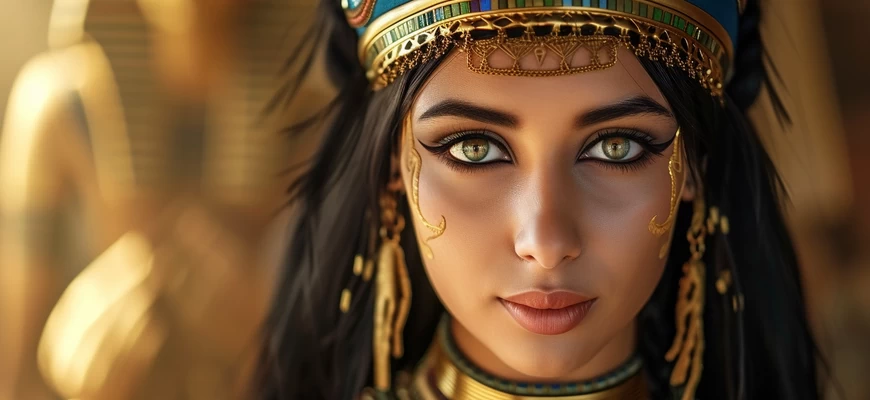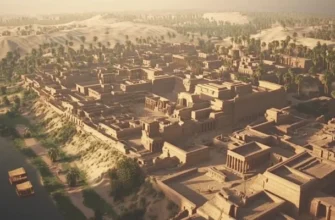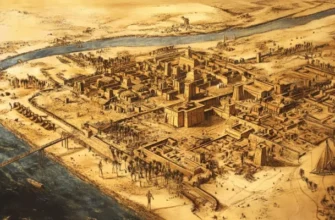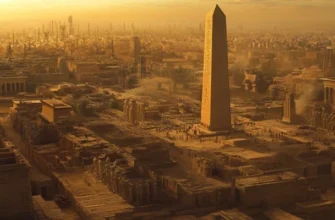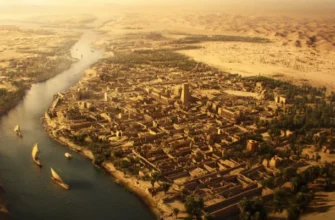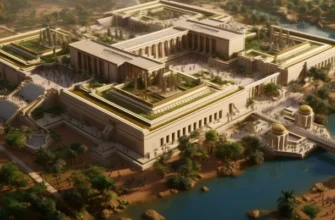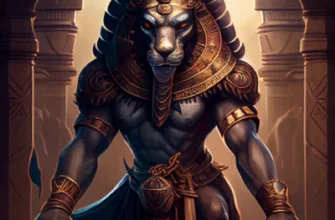Egyptian goddess Tefnut embodies water, sky and the power of the cosmos in ancient Egyptian mythology. The sister and wife of the god Shu, she is the mother of other gods. The image of Tefnut symbolizes order and harmony, and her dominion over the storms expresses power.
Tefnut’s origin is associated with the water Nun, and her children, Geb and Nut, represent the earth and the sky, respectively.
The image of the goddess can be a lioness or a woman with a lion’s head, symbolizing strength and dominance.
In the myths, Tefnut played an important role in creating the world and determining the cosmic laws. One of the key myths is the divorce of Nut and Geb.
The cult of Tefnut proved to be significant, witnessing shrines and temples where religious rites were performed to ensure blessings and harmony.
The image of Tefnut influenced Egyptian art and architecture, reflecting important aspects of local culture. Tefnut leaves its mark on the culture and mythology of ancient Egypt as the embodiment of power and order in the cosmos.
- The role of the goddess Tefnut in the pantheon
- Mythological origin
- Origin and genealogy
- Relationship to other gods
- Attributes and Representations
- Symbols and iconography
- Role in Myths and Legends
- Important myths involving Tefnut
- Cult and Rites
- Shrines and temples dedicated to Tefnut
- Religious rites and festivals
- Influence on Culture and Art
- Reflections in art and architecture
- Conclusion
The role of the goddess Tefnut in the pantheon
The goddess Tefnut played a key role in the pantheon of ancient Egyptian mythology. As the embodiment of water and sky, she was one of the first deities to emerge from chaos (Nun). Together with her male brother Shu, they formed the first divine family.
Tefnut is the mother of Geb (earth) and Nut (sky), which determines her importance in the creation and maintenance of the world. Her role is also connected to the cosmic order, and she acted as an intermediary between the heavenly and earthly worlds.
Tefnut’s involvement in myths and legends, particularly in the myth of the separation of Nut and Geb, emphasizes her importance in shaping the cosmic structure. The goddess was also associated with storms and the unpredictability of natural phenomena, which gave her power.
Tefnut was admired and revered within Egyptian civilization, and her cult and rituals reflected her greatness and influence on religious practice at the time.
Mythological origin
Tefnut, the Egyptian goddess, arose from the progenitor of chaos, Nun. Her origin is connected to water, which was defined as the original substance of all things. Tefnut was formed together with her male brother Shu as a result of the divine magical action of water.
In Egyptian mythology, Tefnut was considered one of the first gods to be born from Nun, and she and Shu became the family deities for other important deities such as Geb and Nut.
This mythological origin of Tefnut laid the foundation for the formation of the cosmic hierarchy and the creation of the universe in ancient Egyptian culture. The goddess played an important role in the creation and ordering of the world, and her origin was a key aspect of her mythological image.
Origin and genealogy
Tefnut, known as the Egyptian goddess of moisture and the sky, arose from the progenitor of chaos, Nun. According to mythology, she and her male brother Shu emerged from a self-realization or magical emergence from the watery space.
Tefnut and Shu became the parents of two other important gods in the Egyptian pantheon: Geba, who represented the earth, and Nut, who ruled the sky. Thus, Tefnut occupied a central place in the genealogy of the gods, acting as the mother and representative of important cosmic elements.
This genealogy determined Tefnut’s role in shaping the structure of the world and establishing important cosmic connections in Egyptian mythology. Her legacy influenced the understanding of the cosmic order and natural phenomena in the context of ancient Egyptian religion.
Relationship to other gods
Tefnut, as the Egyptian goddess of moisture and the sky, has deep connections to other gods in the Egyptian pantheon. Her personal history and family connections make her a key figure in the deity structure of the time.
Shu: Tefnut is the sister and wife of Shu, the god of air and atmosphere. Together they form the first divine family, which has a decisive influence on the creation of the universe.
Geb and Nut: As the father and mother of Geb (the god of the earth) and Nut (the goddess of the sky), Tefnut is part of the family lineage that defines the key cosmic elements of earth and sky.
Ra: Tefnut is often associated with the sun god, Ra. She sometimes acts as his guardian or protector, which emphasizes her importance in the world order and the fight against chaos.
These relationships demonstrate Tefnut’s expanded role in the divine world, where she interacts with other gods to help create and maintain the cosmic order.
Attributes and Representations
Tefnut’s attributes and representations in Egyptian mythology reflect her important aspects as the goddess of moisture, the sky, and cosmic order.
Image: Tefnut is usually depicted as a woman with a lion’s head or as a lioness. This symbolizes her strength and power and is also associated with deities associated with powerful beasts.
Symbols: The main symbols of Tefnut are the lioness or lioness, indicating her imperious nature and majesty. Water and celestial elements may also be incorporated into her image to emphasize her cosmic origins.
Attributes: The goddess often holds symbols of power, such as a rod or ankh, indicating her role in establishing order in the cosmos and providing life energy.
Greater Pantheon: Tefnut may appear alongside other goddesses such as Nut or Isis, emphasizing her interconnections and role in the mythological community.
The image of Tefnut and her attributes play an important role in reflecting her functions as a deity with power over water, the sky, and the cosmic order in the Egyptian pantheon.
Symbols and iconography
Symbols and iconography of Tefnut in Egyptian mythology are reflected through a number of characteristic signs and images that give her uniqueness and define her in a religious context.
Lioness or Lioness: One of the main symbols of Tefnut is the image of a lioness or lioness. This indicates her domineering and protective qualities that make her a powerful goddess.
Rod and Ankh: Tefnut often holds a rod of power or the ankh symbol, which represents life. These attributes indicate her power over the cosmic order and her role in providing life energy.
Celestial and Water Elements: Sometimes her iconography may include images of celestial elements such as stars or the sun, or symbols of water, emphasizing her cosmic and water origins.
Lion’s Head: Her head, often depicted as a lion’s head, expresses strength and power over other creatures.
These symbols and iconographic elements combine to create a recognized image of Tefnut, reflecting her roles as the ruler of water and sky, the protector of order and majesty in the Egyptian pantheon.
Role in Myths and Legends
Tefnut played a significant role in numerous myths and legends of ancient Egyptian mythology, making key contributions to the creation of the world and the definition of cosmic laws. Several important aspects of her role can be highlighted:
Creation of the World: Tefnut, along with her male brother Shu, participated in the process of creating the world. Their emergence from the chaos of Noon symbolizes the first creation of order in the cosmos.
The myth of the Separation of Nut and Geb: Tefnut played a key role in the myth of the separation of Nut (heaven) and Geb (earth). According to the story, she temporarily left Egypt because of dissatisfaction with her partner, her brother, and her return determined the fate and relationship of these two deities.
Participation in the Great Myths: Tefnut was involved in a variety of myths related to other gods of the pantheon. Her presence in stories where other important deities appear determined her importance in the fabric of mythology.
Symbol of the Ruling Power: As the ruler of the storms and the protector of order, Tefnut acted as a symbol of power that maintained stability and balance in the world.
Tefnut’s role in myths and legends not only reflected her individual aspects, but also influenced the understanding of cosmic phenomena and divine hierarchy in ancient Egyptian mythology.
Important myths involving Tefnut
In ancient Egyptian mythology, there are several important myths in which the goddess Tefnut played a role. A few of them are worth noting:
Myth of the Origin of Tefnut and Shu:
One of the most important myths is the moment Tefnut and her brother Shu emerged from the progenitor of chaos, Nun. This defines their role in creating the cosmic order and shaping the world.
The myth of Tefnut’s departure from Egypt:
In the myth of the separation of Nut and Geb, Tefnut temporarily left Egypt due to a quarrel with her male brother Shu. Her absence led to important events that determined the further development of mythology.
The myth of the Return of Tefnut:
In this myth, Tefnut returns to Egypt, resolving the conflict and establishing order between Nut and Geb. This turn determines the further course of cosmic events.
Myths involving Ra:
Tefnut frequently interacted with the sun god, Ra, in other myths, which emphasizes her importance as a deity associated with the forces of nature and cosmic phenomena.
These myths help to reveal important aspects of Tefnut’s religious and cultural heritage, to understand her role in the creation of the world and her interaction with other gods in ancient Egyptian mythology.
Cult and Rites
The cult of Tefnut was significant in ancient Egyptian religion, in particular through the construction of shrines and religious rites. Several aspects of its cult and rituals are worth noting:
Shrines and Temples:
Tefnut had her own shrines and temples dedicated to her, where religious rites were performed. These places served as centers of worship and gatherings of believers.
Rites of Sacrifice:
Various rites of sacrifice were performed as part of the cult, including offerings of food, drink, and symbolic objects. The sacrifices were intended to reconcile the goddess and secure her blessings.
Religious festivals:
The organization of religious festivals was an important part of the Tefnut cult. These events included prayers, songs, dances, and various rituals that were celebrated as part of major religious festivals.
Magical Objects and Amulets:
Images of Tefnut could be found in various magical objects and amulets that were used as means of protection and blessing for the faithful.
Cult Objects and Symbols:
The cult of Tefnut included the production and use of special cult objects that reflected her image and symbolism, such as images of the lioness or amulets with her image.
The cult of Tefnut was reflected in various aspects of the daily lives of ancient Egyptian believers, providing a link to the world of deities and showing gratitude and reverence to this goddess of moisture and the sky.
Shrines and temples dedicated to Tefnut
Unfortunately, there are a limited number of specific shrines and temples dedicated to the goddess Tefnut in historical sources. However, it is important to note that many shrines and temples of ancient Egyptian mythology and religion have not survived or have been destroyed by time.
The famous Temple of Tefnut in Isimbarka, located in Karnak, was dedicated to Tefnut, but now it is partially destroyed. This temple was built by Pharaoh Thutmose III and other rulers.
Other possible sites of the Tefnut cult may be temples in Menphis, Heliopolis, and other areas of Egypt where major religious centers were located.
Despite the limited specific data, it can be assumed that shrines and temples dedicated to Tefnut played an important role in the religious life of the ancient Egyptian people, serving as places of rituals, ceremonies, and worship.
Religious rites and festivals
Ancient Egyptian religious rituals and festivals dedicated to the goddess Tefnut were an important part of the religious life of this culture. Although specific details may be limited due to the distance in time, it is possible to take into account the general features of rites and festivals in the ancient Egyptian cult of Tefnut:
Rites of Sacrifice:
Sacrificial rites were performed in temples dedicated to Tefnut. Sacrifices included food, drink, and symbolic objects that had special religious significance.
Religious prayers and chants:
Worshippers performed a variety of prayers and chants to express their prayers to Tefnut and to pay homage to the goddess. These religious texts often had their own unique forms and symbolism.
Festivals and Ceremonies:
Religious festivals dedicated to Tefnut took place in large temples and shrines. These festivals included a variety of ceremonies, rituals, and public events designed to celebrate the deity and worship together.
Artistic Representations:
Art and symbolism played an important role in religious rites. Depictions of Tefnut in various aspects, as well as magical amulets and objects, were used to enhance the religious experience of the faithful.
These religious rituals and festivals were a way of expressing faith and worshipping Tefnut together, promoting community unity and interaction with the deity within Egyptian mythology.
Influence on Culture and Art
The cult of Tefnut influenced the culture and art of ancient Egypt, leaving its mark on various aspects of civilization.
Religious Symbolism in Art:
Depictions of Tefnut often found their way into the art of ancient Egypt. Her image was typically used as a symbol of ruling power and order. Religious texts and other religious objects also had a great influence on art.
Architectural structures:
Shrines and temples dedicated to Tefnut became architectural masterpieces. Many of these structures were built with great artistic intensity, and their design reflected religious concepts and cultic beliefs.
Religious Rites in Art:
Scenes of religious rites and ceremonies dedicated to Tefnut were embodied in art on the walls of temples and shrines. Painting and sculpture were important means of expressing religious beliefs.
Connection with Other Gods:
The art represented Tefnut’s interaction with other gods, in particular with his brother Shu and the children Nut and Geb. This allowed the deities to be depicted as a single entity.
Amulets and Talismans:
Images of Tefnut were also used to make amulets and talismans, which played an important role in people’s daily lives, protecting them from evil forces and providing blessings.
The influence of the cult of Tefnut on Egyptian culture and art was significant, causing a flourishing of creativity and religious expression in this majestic civilization.
Reflections in art and architecture
The reflection of the Tefnut cult in the art and architecture of ancient Egypt was manifested through a variety of images, symbols, and building structures. Here are some aspects of reflection in art and architecture:
Architectural structures:
Temples and shrines dedicated to Tefnut reflected the grandeur and art of ancient Egyptian architecture. The structures had impressive colonnades, huge staircases, and hieroglyphic images that conveyed religious concepts.
Reliefs and murals:
Images of Tefnut were found on reliefs and murals in temples. The art depicted the goddess as a lioness or a woman with domineering features.
Magical Amulets and Charms:
Images of Tefnut were used to create magical amulets and talismans that were considered protective and brought blessings. These objects had an impact on the daily lives of the faithful.
Pediments and Statues:
The pediments of temples were often decorated with images of Tefnut and other deities, reflecting their importance. Statues were also displayed at the entrances and courtyards of temples.
Symbolism and Painting:
Various symbols such as the lioness and other attributes of Tefnut were used in paintings and murals to emphasize her characteristics and role in the pantheon.
The reflection of the cult of Tefnut in art and architecture is an important aspect for understanding the religious and cultural aspects of ancient Egyptian society. Art served as a means of expressing and celebrating deities, facilitating interaction between humans and the world of deities.
Conclusion
The goddess Tefnut was an extremely important figure in ancient Egyptian mythology and religion. Her image reflects the power of water and the sky. Tefnut’s role in the creation of the world, her participation in various myths, and her influence on culture and art remain an unknown legacy for contemporary research and reflection.
The legacy of the cult of Tefnut is manifested in the study of the history and art of ancient Egypt, where its image and symbolism remain an object of research and a source of inspiration for contemporary artists. Understanding the religious concepts associated with Tefnut helps to reveal the deeper aspects of the culture and spirituality of ancient Egypt.
In the modern world, one can also observe the influence of archaic Tefnut symbols in the context of contemporary spiritual and creative realities. The symbolism of the lioness and other attributes of Tefnut can be embodied in contemporary artworks, amulets, or even in the creation of new religious concepts.
The goddess Tefnut, as the ruler of water and the sky, remains a fascinating and mysterious figure in human history. Her role in the creation of the world, her interaction with other gods, and her influence on the religious and cultural sphere of Egypt make her not only an object of study but also an inexhaustible source of inspiration for those interested in art, religion, and ancient history. Her legacy lives on in historical texts, temples, and art, giving her the eternal status of a great goddess with powerful influence.
